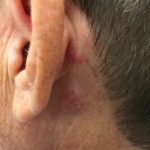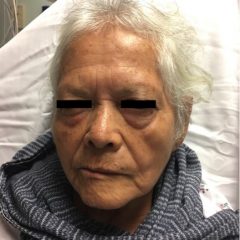An Unusual Case of Pharyngitis: Herpes Zoster of Cranial Nerves 9, 10, C2, C3 Mimicking a Tumor
History of present illness:
A 53-year-old male presents to a local community emergency department complaining of sore throat, difficulty swallowing, hoarseness of voice and odynophagia progressively worsening for 5 days. He states symptoms started two weeks ago with intractable hiccups and a bitter taste in the back of his tongue when eating. At that time, he saw his primary care provider and was subsequently prescribed chlorpromazine and omeprazole for presumed gastroesophageal reflux. His symptoms improved transiently, but then started to have difficulty swallowing his own secretions, at which point he presented to the emergency department.
Significant findings:
On exam, the patient was sitting upright while holding an emesis basin filled with saliva. His voice was noticeably hoarse. Examination of the head and neck revealed vesicular eruptions on the left scalp in the V1 dermatome and on the left mastoid process (Images 1 and 2). Physical exam also shows vesicular eruptions on the left posterior oropharynx that did not cross midline (Image 3). There was also a mass seen in the left peritonsillar area suspicious for peritonsillar abscess. There was slight deviation of the uvular to the right. His vital signs were temperature of 99.0F; heart rate, 75 beats/min; blood pressure, 135/80 mm Hg; and respiratory rate, 16 breaths/min. Oxygen saturation was 99% on room air.
Due to concern for deep neck space infection, a computed tomography (CT) scan of the neck and soft tissue was done with intravenous (IV) contrast. The CT neck with IV contrast (image 4) shows a left parapharyngeal mass causing mild airway shift to the right. The mass measures approximately 5cm in length and 2cm in diameter. Radiology commented this is most likely an inflammatory process of the peritonsillar tissue, but he could not rule out a malignant process.
Discussion:
A clinical diagnosis of Varicella zoster virus (VZV) was made based on the skin findings. In this case the glossopharyngeal (cranial nerve 9), vagal (cranial nerve 10), 2ndand 3rdcervical nerves (C2, C3) were affected. Glossopharyngeal zoster will cause odynophagia, dysgeusia, and loss of the ipsilateral gag reflex.6 Vagal nerve zoster causes hoarseness of voice, difficulty swallowing, and rarely, intractable hiccups. During hiccups, the afferent nerve pathway travels along the vagus and phrenic nerve fibers. The phrenic nerve (C3-C5) serves as the primary efferent pathway.4 Our patient presented with odynophagia and dysgeusia in relation to cranial nerve (CN) 9 as well as hoarseness and intractable hiccups in relation to CN10. The mass-occupying lesion seen on CT is adjacent to the left external carotid and internal jugular veins. This most likely represents inflammatory swelling of CN 10, which passes anatomically through the carotid sheath. Herpes occipitocollaris (vertebral nerves C2 and C3) involves the posterior scalp, mastoid process, and auricle.7 Branches of these nerves communicate with CN 7 and CN 10, often causing symptoms related to these nerves as well. Disseminated zoster is defined as 20 or more vesicles outside of the primary and adjacent dermatomes, which our patient did not have.8
Our patient’s dysphagia was likely due to a combination of CN 9 palsy and pain from the peritonsillar mass. Given the degree of dysphagia and complaint of bitter taste sensation in the posterior tongue, CN 9 was most likely involved.6 His hiccups were a prodromal symptom of zoster infection caused by vagal nerve irritation. To date only six cases are documented.4 The diagnosis is difficult to make if the dermatologic manifestations are not apparent early on in the disease process.
This patient was treated with 125mg IV solumedrol, 60mg intramuscular (IM) ketorolac, and 4mg IV morphine. After treatment, the patient’s pain improved and was able to tolerate PO intake and handle secretions. Otolaryngology (ENT) was consulted and recommended the patient be discharged home with valacyclovir 1g orally twice daily, prednisone 40mg orally daily, and 4% viscous lidocaine with follow up in two days. When speaking with ENT months later, I was informed the patient continued to improve with medical treatment and symptoms had fully resolved. A repeat CT was not done due to resolution of symptoms attributed to acute zoster infection.
Topics:
Herpes Zoster, infectious disease, cranial nerves, head and neck.
References:
- Mevio E. Unusual Manifestation of Herpes Zoster Infection Involving the Greater, Lesser Occipital and Transverse Cervical Nerve: A Case Report. J of Otolaryngology and Rhinology. 2015;1:1-2.
- Adachi, M. A Case of Varicella Zoster Virus Polyneuropathy: Involvement of the Glossopharyngeal and Vagus Nerves Mimicking a Tumor. AJNR Am J Neuroradiology. 2008;29(9):1743-1745. doi: 10.3174/ajnr.A1141
- Goh CL, Khoo L. A retrospective study of the clinical presentation and outcome of herpes zoster in a tertiary dermatology outpatient referral clinic. Int J Dermatol. 1997;36(9):667-672.
- Reddy BV, Sethi G, Aggrawal A. Persistent hiccups: A rare prodromal manifestation of herpes zoster. Indian J Dermatol Venereol Leprol. 2007;73:352-353.
- Shim JH, Park JW, Kwon BS, et al. Dysphagia in Ramsay Hunt’s Syndrome – A case report. Ann Rehabil Med. 2011;35(5):738–41. doi: 10.5535/arm.2011.35.5.738
- Nakagawa H, Nagasao M, Kusuyama T, Fukuda H, Ogawa K. A case of glossopharyngeal zoster diagnosed by detecting viral specific antigen in the pharyngeal mucous membrane. J Laryngol Otol. 2007;121(2):163-165.
- Davis HJ. Case of Herpes Zoster of the Auricle and Mastoid Region, J Laryngol Otol. 1910;xxv:405.
- Brown TJ, McCrary M, Tyring SK. Varicella-Zoster Virus (Herpes 3). J Am Acad Dermatol. 2002;47:972–997. doi: 10.1067/mjd.2002.124604






